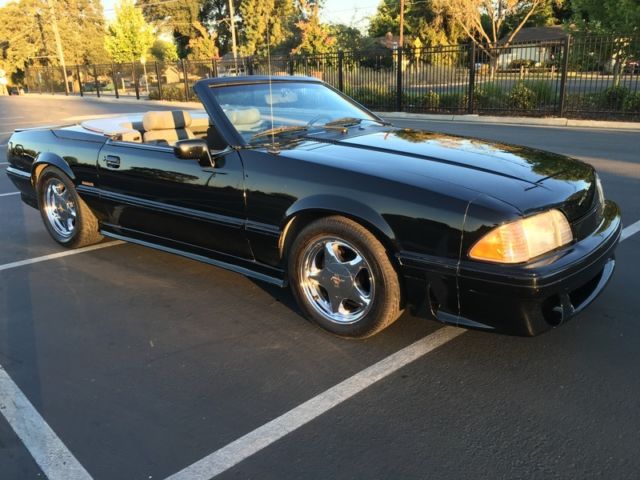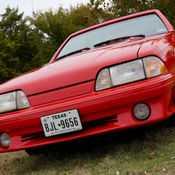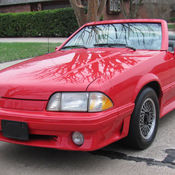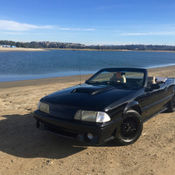1988 Ford Mustang ASC McLaren Convertible RARE One Owner #924 of 1015
- Price: Ask a price!
-
Item location:
Orangevale, California, United States
-
Make:
Ford
-
Model:
Mustang
-
SubModel:
ASC McLaren
-
Type:
Convertible
-
Trim:
ASC McLaren Convertible
-
Year:
1988
-
Mileage:
66,684
-
VIN:
1fabp40e7jf157374
-
Color:
Black
-
Engine size:
5.0 V8
-
Number of cylinders:
8
-
Power options:
Air Conditioning, Cruise Control, Power Locks, Power Windows
-
Fuel:
Gasoline
-
Transmission:
Manual
-
Drive type:
RWD
-
Interior color:
Gray
-
Options:
CD Player, Convertible, Leather Seats
-
Vehicle Title:
Clear
Ford Mustang 1988 Description
1988 Mustang ASC/McLaren Convertible #924 of 1016 built in 88' 66k miles, I'm listing it for a friend of mine is the Original Owner, he has a stack of service records since new. 5.0, GT40 Intake, BBK Throttle Body, BBK Headers, Ford Motorsports Suspension, New Ford Motorsports Clutch, just installed at Ford. Has the ultra rare Recaro seat option The top is pristine, and all of the one off ASC McLaren parts on the car are all nice! It has been a California car its entire life, no rust anywhere. Original paint. Runs and drives great. Smogged, current reg. Here is more info on the design and build of these cars. The ASC/McLaren Mustangs were equipped with the 5.0-liter (302-cu.in.) V-8, and timing could not have been better. Ford, recognizing increased competition from Chevy's Camaro, made adjustments to the existing electrically fuel-injected engine that boosted output from the previous year's 200 hp to 225. This was achieved by installing a larger intake plenum and a 60-mm throttle body, revised Ford truck cylinder heads and 9.0:1 compression forged pistons. For all intents and purposes, the engine, installed standard in every Mustang GT, changed very little during this four-year span. What to watch for: During the 1988 model year, Ford made a running change to the high-output 5.0 when a mass airflow sensor--used for fuel metering--replaced the previously employed speed-density system; however, this only affected cars sold in California. This change was then made to all 5.0 H.O. engines for the 1989 model year. On paper it may seem a minute gesture in the name of efficiency, but the mass airflow sensor has made it easier for owners to make performance modifications without sacrificing drivability, as this system is less sensitive to manifold vacuum readings. Even if you have found an '87 edition, performance alterations can be made with ease, thanks to an expansive aftermarket network. It should be noted that, even modified, the 5.0 engine has long proven itself as a durable unit, able to withstand most punishing conditions and driving styles. TRANSMISSION As with the Mustang GT, the ASC/McLarens were offered with a Borg Warner T-5 five-speed manual transmission as standard equipment. It was a unit that had been introduced to the Mustang in 1983 and was further upgraded in subsequent years; the '87-'90 versions are of the "World Class" variety. The four-speed automatic overdrive (AOD) transmission was offered as an option. Both are reliable units that last for many miles of standard driving, and both can be upgraded for more severe duty if necessary. What to watch for: All Borg Warner T-5 manuals were filled with Mercon Dextron II/III automatic transmission fluid due to the tiny oil transfer holes that lubricate the needle bearings. It is important to use the correct fluid (many of these T-5s were filled with heavy-weight gear lube by inattentive service mechanics) and to monitor fluid levels to help the unit's longevity. Additionally, there were two upgrades, the first of which came in 1989, with a running change from a seven-tooth to eight-tooth speedometer drive gear. For 1990, the torque capacity was increased by installing second and third gears made from improved alloys with a coarser pitch. CHASSIS Starting in 1979, the Mustang had been constructed on the unit-body Fox platform featuring - with minute variations - a 100.5-inch wheelbase. Supporting the McLaren version was a stock Mustang GT independent front suspension system consisting of struts, performance springs and a 1.3-inch anti-roll bar. At the opposite end was the Mustang's Quadra-Shock system, comprised of two vertically installed gas shocks working in unison with two conventional gas shocks horizontally mounted to the differential--the durable 8.8-inch Traction-Lok--to prevent unwanted twisting and wheel hop; an 0.83-inch anti-roll bar was also included. The Mustang GT's power front disc/rear drum brake system was standard equipment. Significant deviations from the factory GT chassis began with the elimination of the stock Mustang wheels. ASC/McLaren carried over its use of the honeycombed mesh, cast-aluminum, 15-inch wheels from the earlier Capri program, which were supplied by Italy's Motorsport Wheel Company. They were shod with directional Goodyear VR radials. For the 1989-'90 models, the same tires were installed on new directional five-slot Enkei wheels from Japan. The other significant change has to do with the unit-body structure. With the removal of the Mustang LX's fixed top, structural rigidity was compromised, a condition that was rectified with the installation of reinforced rocker panels. This was a deviation from practices employed during the Capri program, which added bracing below the rear cowl. What to watch for: The 1987 and up Mustangs featured revised front-end geometry with new strut housings. Strut travel was also increased. Combined, it provided the Fox platform with greater cornering stability. Additionally, the aftermarket industry has been providing suspension and brake upgrades for many years. Although owners of truly rare cars tend to maintain stock characteristics, it's still possible to find an example with such upgrades installed. BODY & INTERIOR Contrary to what one may think, Ford did not send incomplete, body-in-white LX coupes to ASC/McLaren. Each was complete, including the aforementioned 5.0 engine and GT underpinnings. Henry Huisman, who worked at ASC and is now the owner of Paradise Automotive--supplier of NOS, reconditioned and used ASC/McLaren parts in Odessa, Florida (www.ascmclaren.com)--tells us they were also fitted with the GT front fascia from the factory. "Once they took delivery of the car, they cut the top off and removed the interior in order to fit their own manually-folded top and power metal tonneau cover. Like the Capri, they pulled the windshield back about 20 degrees, which necessitated the installation of side windows unique to these cars. They also added side skirts, taillamp covers and a rear spoiler, and removed the stock emblems," explains Henry. Once the exterior modifications were completed, the cars were then painted a variety of special colors, which varied from one year to the next. "Ford shipped the cars, usually finished in silver or black, so in most cases the door sticker--which would have the paint code--will not match what ASC/McLaren ultimately applied. The underside of the hood should still exhibit the original Ford color," cautions Henry. Interiors were also extensively modified. With the rear seat removed, additional storage was made available, à la Corvette, below the stowed top and corresponding cover. The front seats were given extra padding and re-covered in embroidered leather; door panels and the armrests were also redesigned. Standard Mustang GT instrumentation remained, however. Standard features included power steering, tinted windows and even air conditioning later in the series; however, options such as a Whistler radar detector and Recaro bucket seats were few. The Recaros were dropped after 1988, mostly due to the fact few buyers selected the $1,500 option. What to watch for: Henry cautions that in the ensuing years, ASC/McLaren Mustangs have become prone to rust in the rear quarter panels and around the trunk where conversion work was performed, usually on cars that have not been properly maintained. Conversely, the reinforced rockers have proven to be somewhat resistant to corrosion. Also, bear in mind that this was an era in which plastic parts were still struggling to cope with exposure to UV rays and prolonged durability. Finally, a small electric motor used in conjunction with the top conversion has proved to be problematic at times. A 140-MPH speedometer replaced the once-federally mandated 85-MPH gauge in 1989. RESTORATION & PERFORMANCE PARTS Low production throughout its history and the ultimate suspension of the conversion program during the 1990 model year left behind an extensive collection of ASC/McLaren-specific NOS parts, which has been serving the needs of owners and restorers alike since. Coupled with a vast network of OE and aftermarket performance parts suppliers, restoring one of these rare two-seaters--or administering acceleration and cornering enhancements--is far easier than what one might expect from such a low-production specialty model. Engine Providing plenty of grunt for the sporty ASC/McLaren was a standard-issue Mustang GT high-output 5.0-liter engine rated for 225 hp, which was an improvement of 25 horses implemented in time for the 1987 models. No performance mods were made by McLaren. Brakes Stock Mustang GT equipment, including a power front disc/rear drum system was used during all four years of ASC/McLaren conversion production. Rear disc conversions are available, as are stock systems from earlier SVO and later Cobra Mustangs. Transmission No surprises here, as each of these unique custom-built Mustangs was equipped with a Borg Warner T-5 five-speed manual as standard equipment. A four-speed overdrive automatic was a $515 option through 1989, but cost a lofty $595 in '90. Interior A standard Mustang interior was converted into a custom--and true--two-seater, complete with embroidered leather bucket seats, lengthened center console, custom armrests and rear stowage compartments. Stock Mustang instruments were retained. Chassis On the surface, no modifications were made to the standard Mustang chassis. GT equipment, meaning the stock performance suspension system, was bolted into place at the Ford factory. Only the rocker panels were reinforced by ASC/McLaren. Body Interior aside, the body received the bulk of the alterations. Each started life as an LX notchback coupe before the top was cut off, the windshield tipped back and a custom top and metal tonneau cover added, along with side skirts and taillamp covers. ums/mm311/ranchotoyotatruck/Mobile%20Uploads/2016-08/2BD3E2CD-A8AD-4113-BC34-A32A74EDC2EA_zpstxel1r0j.jpg" border="0" alt=" photo 2BD3E2CD-A8AD-4113-BC34-A32A74EDC2EA_zpstxel1r0j.jpg"/>

 RARE 1998 Ford ASC McLaren Mustang #878 of 1015 built 5.0L V8 convertible RARE!
RARE 1998 Ford ASC McLaren Mustang #878 of 1015 built 5.0L V8 convertible RARE!
 1988 Ford Mustang LX ASC McLaren Convertible 5-Speed Leather 1 Of Only 20 RARE!
1988 Ford Mustang LX ASC McLaren Convertible 5-Speed Leather 1 Of Only 20 RARE!
 1988 FORD MUSTANG ASC/MCLAREN CONVERTIBLE RARE FIND 1OWNR ONLY 27K MI
1988 FORD MUSTANG ASC/MCLAREN CONVERTIBLE RARE FIND 1OWNR ONLY 27K MI
 1988 FORD MUSTANG MCLAREN CONVERTIBLE 15K MILES
1988 FORD MUSTANG MCLAREN CONVERTIBLE 15K MILES
 1988 ASC McLaren Ford Mustang Convertible Beautiful
1988 ASC McLaren Ford Mustang Convertible Beautiful
 1988 Ford ASC McLaren Mustang Convertible Unrestored Survivor 28k Original Miles
1988 Ford ASC McLaren Mustang Convertible Unrestored Survivor 28k Original Miles